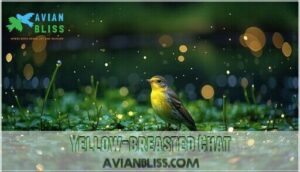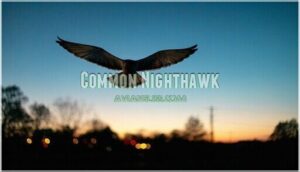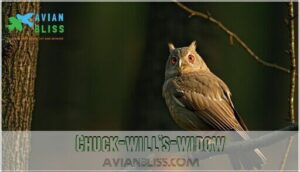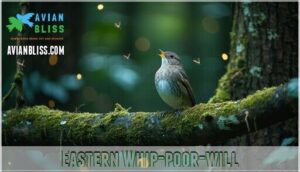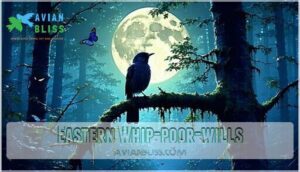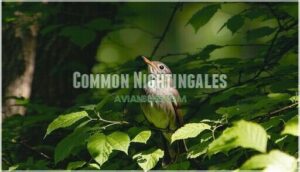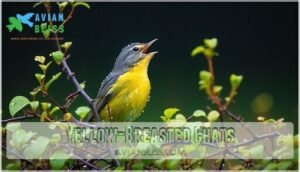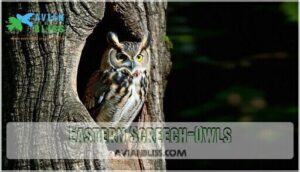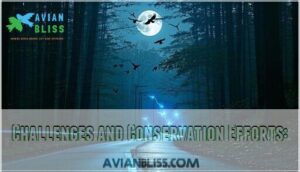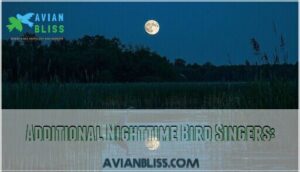This site is supported by our readers. We may earn a commission, at no cost to you, if you purchase through links.
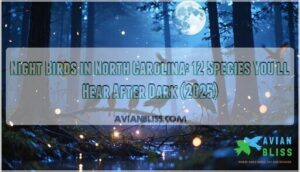
The state’s nocturnal chorus includes the haunting calls of Eastern Whip-poor-wills, melodic Northern Mockingbirds that sing past midnight, and the classic "who-cooks-for-you" hoots of Barred Owls.
Great Horned Owls provide deep bass notes, while Eastern Screech-Owls add their distinctive trills.
Common Nighthawks dive-bomb through summer skies, and both Black-crowned and Yellow-crowned Night-Herons patrol waterways.
Chuck-will’s-widows and Yellow-breasted Chats round out this feathered nighttime orchestra.
Each species has evolved specialized adaptations for darkness, creating an entire ecosystem that most folks never notice after sunset.
Table Of Contents
- Key Takeaways
- Common Nighttime Birds in North Carolina:
- Notable Characteristics of Nighttime Birds:
- Challenges and Conservation Efforts:
- Additional Nighttime Bird Singers:
- Frequently Asked Questions (FAQs)
- Why do birds chirp at night in North Carolina?
- What kind of birds make noise at night?
- What birds are active at night?
- Why do I hear birds at 2am?
- What time do nocturnal birds become active?
- How do night birds navigate in darkness?
- What attracts nocturnal birds to backyards?
- Do night birds migrate during winter months?
- How can I identify nocturnal birds by sound?
- Conclusion
Key Takeaways
- You’ll encounter twelve distinct nocturnal bird species in North Carolina, including the haunting Eastern Whip-poor-will with its repetitive three-syllable call, the melodic Northern Mockingbird that mimics over 200 sounds, and the iconic Barred Owl asking "Who cooks for you?"
- You can identify these night birds by their unique calls and behaviors—Great Horned Owls deliver deep bass hoots, Eastern Screech-Owls produce horse-like whinnying sounds, and Common Nighthawks dive through summer skies with distinctive "peent" calls.
- You’re witnessing birds with specialized adaptations for darkness, from owls’ silent flight feathers and exceptional hearing to night-herons’ patient hunting strategies and the camouflaged plumage that makes whip-poor-wills nearly invisible during daylight.
- You can help protect these declining populations by supporting habitat conservation efforts, keeping cats indoors, using bird-friendly building designs to prevent collisions, and creating backyard environments with native plants and water sources that attract nocturnal species.
Common Nighttime Birds in North Carolina:
You’ll discover twelve fascinating bird species that fill North Carolina’s nights with their distinctive calls, from the haunting hoots of owls to the melodic songs of mockingbirds.
These nocturnal performers include everything from tiny screech-owls that sound like horses whinnying to chuck-will’s-widows whose names perfectly match their repetitive calls.
From whinnying screech-owls to name-calling chuck-will’s-widows, North Carolina’s night shift never lacks personality.
Northern Mockingbird
During the witching hours of North Carolina nights, you’ll hear Northern Mockingbirds showcasing their incredible mimicry repertoire.
These gray-and-white songsters copy over 200 different sounds, from car alarms to other bird calls.
Young males sing most actively after dark, repeating each imitation three times before switching.
Their song complexity rivals any North Carolina birds, though population trends show concerning declines.
Urban adaptations help them thrive near streetlights, making bird identification easier for nighttime listeners.
Yellow-breasted Chat
Among North Carolina’s most intriguing nocturnal birds, the Yellowbreasted Chat delivers a symphony of bizarre sounds that’ll make you wonder what’s hiding in those thickets.
These summer migrants arrive with quite the repertoire:
- Chat Vocalizations include whistles, croaks, and mechanical sounds
- Breeding Behavior involves nighttime serenades to attract mates
- Habitat Needs center on dense shrublands near water sources
- Conservation Status remains concerning due to declining populations
These NC birds face habitat loss, but their quirky nocturnal concerts still enchant those lucky enough to hear them during Summer Migrations.
Common Nighthawk
You’ll recognize this night bird by its distinctive white wingbars cutting through North Carolina’s evening sky.
The Common Nighthawk’s erratic flight patterns make it look like a feathered bat as it darts after insects.
Its camouflaged plumage keeps it hidden during daylight hours, but those sharp "peent" calls give it away at dusk.
| Characteristic | Details |
|---|---|
| Size | 9-10 inches, dove-sized |
| Flight Pattern | Erratic, bat-like movements |
| Diet | Flying insects (insectivore) |
| Habitat | Open woodlands, fields, cities |
This crepuscular insectivore thrives in open habitats where nocturnal birds can hunt effectively.
Chuck-will’s-widow
Chuck-will’s-widow produces melancholic calls that echo through North Carolina’s forests after dark.
This largest nightjar in North America spans 11-13 inches with mottled brown plumbing that camouflages perfectly against tree bark.
You’ll spot its bright orange eyeshine in headlights as it hunts along roadsides.
Key features of this remarkable nocturnal bird:
- Habitat needs: Dry woodlands from pine barrens to oak-hickory forests
- Insect diet: Moths, beetles, and flying insects caught mid-air
- Southern migration: Winters in Caribbean and Central America
- Population decline: Facing threats from habitat loss
- Bird sounds: Distinctive "chuck-WILL’S-widow" whistle at dusk
These Chuck-will’s-widow don’t build nests—they lay eggs directly on forest floors among dead leaves.
Eastern Whip-poor-will
When darkness falls across North Carolina’s forests, you’ll hear the Eastern Whippoorwill’s iconic song echoing through the trees.
This medium-sized nocturnal bird delivers its haunting three-syllable call continuously on spring evenings, creating folklore significance that has inspired countless stories and poems.
Unfortunately, population decline threatens these remarkable night birds due to habitat loss from suburban development.
The whippoorwill’s distinctive white throat patch and mottled brown camouflage make it nearly invisible during daylight hours.
Conservation targets now focus on protecting the mixed deciduous forests these nocturnal birds need for survival.
Black-crowned Night-Heron
While whip-poor-wills serenade with repetitive calls, you’ll encounter the Black-crowned Night-Heron’s harsh "quawk" echoing across North Carolina’s wetlands after dark.
These stocky nocturnal birds wade through marshes and swamps, using their strong bills to snatch fish, frogs, and crustaceans during their nighttime hunts.
You’ll spot their distinctive black caps and gray wings as they patrol shallow waters from dusk till dawn.
Their nocturnal foraging behavior helps them avoid competition with day-active herons.
These intelligent hunters often stand motionless before striking with lightning speed.
- Wetland Habitat: Thrives in fresh, salt, and brackish marshes throughout the state
- Conservation Status: Stable populations but vulnerable to habitat destruction
- Breeding Behavior: Nests colonially in stick platforms, often over water
Yellow-crowned Night-Heron
While the Black-crowned Night-Heron hunts in darkness, you’ll find its cousin, the Yellow-crowned Night-Heron, stalking coastal waters with equal stealth.
This stocky wader displays a striking gray body with distinctive yellowish crown plumes that catch moonlight beautifully.
Identification Tips for spotting this nocturnal bird include:
- Gray body contrasting with black head and bright crown
- Orange-yellow legs that glow in dim light
- White cheek streak below the eye
- Stocky build with 3-foot wingspan
- Hunched posture while foraging
Habitat Preference centers on coastal wetlands, though they’ll venture inland along wooded river valleys.
Dietary Habits focus heavily on crabs and crayfish, which they shake apart with impressive force.
Their beak crushes shells with specialized precision.
Breeding Behavior involves secretive colony nesting, while Conservation Status remains stable despite coastal development pressures threatening North Carolina’s night birds.
Great Horned Owl
You’ll recognize the Great Horned Owl by its distinctive feather tufts and piercing yellow eyes.
These adaptable nocturnal birds thrive across North Carolina’s diverse landscapes, from forests to suburbs. Their hunting strategies include silent flight and powerful talons that can crush prey.
Among owl species, they’re apex predators with remarkable habitat adaptability. Regional variations show slight size differences, while their nesting habits involve claiming abandoned hawk or crow nests for early breeding.
| Feature | Description |
|---|---|
| Physical Traits | Prominent ear tufts, yellow eyes, mottled brown plumage |
| Hunting Style | Silent flight, powerful grip strength up to 300 psi |
| Preferred Habitat | Woodlands, swamps, parks, suburban areas |
| Nesting Behavior | Reuses old nests, breeds January-March |
| Diet Range | Mammals, birds, reptiles, amphibians, fish |
Barn Owl
That ghostly white shape floating silently through the darkness? You’ve spotted a Barn Owl, one of North Carolina’s most distinctive nocturnal birds.
These heart-faced hunters patrol open fields and farmland, using their incredible hearing to pinpoint mice and voles below. Their habitat preferences include old barns, silos, and hollow trees for nesting habits.
Unfortunately, their conservation status shows concern as modern farming reduces suitable roosting sites. Supporting owl-friendly agriculture helps maintain their hunting strategies and guarantees future generations can witness these remarkable owl species.
These ghostly hunters remind us that protecting farmland habitats means preserving nature’s most enchanting midnight performers.
Barred Owl
Looking for a feathered friend with a memorable voice? The Barred Owl delivers North Carolina’s most recognizable nocturnal serenade with its famous "**Who cooks for you?
**" call.
This owl species prefers mature forests and wooded swamps, where its Barred Owl Diet includes small mammals, amphibians, and fish.
Unlike the Great Horned Owl, barred owls show impressive Call Variations and Range Expansion across eastern forests.
These nocturnal birds maintain stable Conservation Status despite some Habitat Preference challenges from development.
Short-eared Owl
Among North Carolina’s nocturnal birds, the Short-eared Owl stands out as a rare winter visitor you’ll rarely encounter.
This medium-sized owl with yellow eyes and tiny ear tufts prefers open marshes and weedy fields for its habitat preferences. Unlike other night birds, it hunts during daylight using keen hearing and sight as hunting strategies.
Its conservation status remains concerning—most twentieth-century reports involved injured individuals. Identification tips include heavily streaked plumage and whitish facial patches.
Bird conservation efforts focus on protecting remaining grassland habitats essential for this elusive Short-eared Owl’s survival, which is crucial for its conservation status.
Eastern Screech-Owl
The Eastern Screech-Owl might be North Carolina’s most overlooked nocturnal wildlife, perfectly hidden in plain sight thanks to its remarkable Screech-Owl Camouflage.
These pocket-sized night predators blend seamlessly into tree bark, making bird watching a real challenge even in Urban Habitats where they’ve adapted surprisingly well.
- Vocalizations: Their signature trill sounds more like a ghostly whistle than a screech, echoing through neighborhoods after dark.
- Diet Diversity: They’ll hunt everything from moths and beetles to small rodents and frogs, adapting their menu to what’s available.
- Conservation Status: While stable overall, habitat loss threatens local populations across the state.
You’ll find these adaptable owls thriving in wooded suburbs, parks, and backyards throughout North Carolina, proving that some wildlife can flourish alongside human development when given the chance.
Notable Characteristics of Nighttime Birds:
You’ll notice that North Carolina’s night birds have special features that help them thrive in darkness, from the mockingbird’s impressive vocal range to the owl’s silent flight feathers.
These nocturnal singers use different tricks than daytime birds, whether it’s the whip-poor-will’s camouflage patterns or the night-heron’s patient hunting style.
Northern Mockingbirds
Several Northern Mockingbirds showcase their impressive mimicry repertoire during North Carolina’s nighttime hours.
You’ll hear these talented vocalists copying car alarms, cell phone rings, and other bird calls with remarkable accuracy.
Their vocal learning abilities and territorial behavior make them fascinating night birds for bird watching enthusiasts, despite their declining conservation status.
| Characteristic | Description |
|---|---|
| Mimicry Repertoire | Copies 50+ different sounds including birds, insects, and mechanical noises |
| Urban Adaptation | Thrives in cities, parks, and suburban neighborhoods across North Carolina |
| Vocal Learning | Masters new sounds throughout their lifetime, especially during breeding season |
| Territorial Behavior | Males sing loudly at night to defend territory and attract mates |
Eastern Whip-poor-wills
You’ll recognize the Eastern Whip-poor-will’s haunting three-syllable call echoing through North Carolina’s forests. This secretive nightjar species, closely related to the Chuckwillswidow, demonstrates fascinating folklore connections linking their nocturnal bird species songs to ancient superstitions.
These nocturnal insectivores showcase remarkable migration patterns, traveling from breeding grounds to wintering areas. For accurate identification, a portable field guide is essential.
- Song variations include rapid repetitions reaching 400 calls per hour
- Habitat specifics require semi-open deciduous forests with minimal understory
- Insect diet consists primarily of moths and flying beetles caught mid-flight, which is a key aspect of their nocturnal insectivores behavior and fascinating folklore connections.
Barred Owls
You’ll recognize the barred owl’s unmistakable "**Who cooks for you?
**" call echoing through North Carolina’s mature forests and swamps.
Unlike the great horned owl, this nocturnal hunter prefers dense woodlands for its habitat preference.
Their diet specifics include small mammals, amphibians, and fish. Call variations include hoots, cackles, and even cat-like sounds.
Range expansion continues westward, making birding NC more exciting as these vocal nocturnal animals establish new territories throughout the state.
Common Nightingales
You won’t find Common Nightingales singing in North Carolina’s forests—these legendary songsters stick to their European Distribution across Europe and western Asia.
Their complex Nightingale Song has inspired poets for centuries, but unlike our local nightjar species including the Common Nighthawk, nightingales don’t call North America home.
Their Migration Patterns take them between European breeding grounds and African wintering areas.
Conservation Status remains stable, though Habitat Preferences for dense thickets face development pressure throughout their range.
Yellow-Breasted Chats
Picture a feathered entertainer mixing chips, whistles, and chattering sounds into one wild performance—that’s your yellow-breasted chat. These vibrant birds bring some of the most unusual chat vocalizations you’ll hear in North Carolina’s summer nights.
Their quirky tunes sound like a robin having a conversation with a grackle, but way more animated. You’ll spot these wildlife gems in shrubby fields and forest edges during their summer migrations from southern wintering grounds.
Unfortunately, their conservation status isn’t great—habitat loss threatens these remarkable singers. Development pressures destroy the dense thickets they need for nesting, making habitat needs a critical concern for North Carolina wildlife enthusiasts.
These birds deserve our protection efforts. By supporting habitat restoration in your area, you’re helping guarantee future generations can enjoy their distinctive songs. Your North Carolina wildlife guide wouldn’t be complete without appreciating these threatened performers and their essential animal habitats.
Eastern Screech-Owls
Eastern Screech-Owls rarely show themselves during daylight hours, but you’ll definitely hear their distinctive nocturnal calls echoing through North Carolina’s woodlands.
These masters of Screech-Owl Camouflage blend seamlessly into tree bark, making them nearly invisible to both prey and predators.
Their Screech-Owl Calls include:
- A bouncing ball trill for territory defense
- Short, upward whistling songs during courtship
- Begging calls from hungry nestlings
- Aggressive, rattling alarm calls
Unlike Great Horned Owls or Barred Owls, these compact nocturnal animals thrive in diverse Screech-Owl Habitats from forests to suburbs, with their varied Screech-Owl Diet supporting healthy populations.
Challenges and Conservation Efforts:
You’ll discover that North Carolina’s night birds face serious threats from habitat loss, vehicle collisions, and wind turbines that make their nighttime world increasingly dangerous.
Fortunately, conservation groups are working hard to protect these feathered night shift workers through habitat preservation, the Cats Indoors program, and efforts to reduce the hazards that threaten their survival.
Habitat Loss
Bulldozers and chainsaws have become the soundtrack of change across North Carolina, reshaping landscapes that nocturnal birds call home. You’ll find that habitat loss strikes these feathered night-shift workers particularly hard.
Forest fragmentation splits their territories into puzzle pieces, while wetland destruction eliminates essential feeding grounds for species like the Black-crowned Night-Heron. Urban sprawl creeps steadily outward, replacing prime owl habitat with shopping centers and subdivisions.
Agricultural expansion compounds the problem, converting diverse ecosystems into monoculture fields that can’t support varied bird populations. When you consider that some species need large, unbroken territories to thrive, it’s no wonder bird population declines have accelerated.
Conservation strategies offer hope through habitat corridors that connect fragmented areas and wetland restoration projects. Supporting NC habitat restoration can help to reverse this trend. Protecting existing bird habitats while creating new ones becomes essential for avian conservation. Smart development planning can help balance human needs with wildlife requirements.
Bird Collisions With Vehicles and Glass
When darkness falls, North Carolina’s night birds face deadly obstacles they can’t see coming.
Vehicle collisions claim thousands of migrating birds annually, while glass reflections from buildings create invisible walls that confuse disoriented fliers.
Light pollution compounds these problems, drawing birds off their natural flight paths toward artificial illumination.
Simple mitigation strategies like window decals, motion-sensor lighting, and bird-friendly building design can dramatically reduce these preventable deaths.
Applying effective window treatments can help prevent collisions, and small changes in how we illuminate and construct our spaces save countless nocturnal species from unnecessary harm, through the use of effective window treatments and simple design changes.
Risks Posed by Wind Turbines
Wind turbines present significant challenges for North Carolina’s nocturnal birds through habitat fragmentation and deadly blade strikes.
You’ll find that bat fatalities spike near poorly placed turbines, while bird collisions increase during migration periods.
Turbine placement in critical flyways disrupts centuries-old travel routes, forcing birds into dangerous detours.
Smart mitigation strategies can help:
- Installing bird-friendly lighting systems that reduce disorientation
- Conducting thorough environmental assessments before construction
- Positioning turbines away from major migration corridors to minimize blade strikes
Conservation Efforts and Critical Habitat Protection
Looking beyond wind turbine impact, conservationists are rolling up their sleeves to protect North Carolina’s night singers.
Habitat restoration projects target whip-poor-will breeding grounds while protected areas shield critical stopover sites.
Reducing collisions through bird-friendly building designs helps too.
Community science programs let you contribute data on avian conservation efforts, supporting North Carolina biodiversity research that guides future protection strategies.
Citizen science programs let you contribute data on avian conservation efforts, supporting North Carolina biodiversity research that guides future protection strategies.
| Conservation Strategy | Key Focus Areas |
|---|---|
| Habitat Restoration | Breeding grounds, native plant corridors |
| Protected Areas | Critical stopover sites, nesting habitats |
| Collision Prevention | Bird-friendly building designs, lighting regulations |
The Cats Indoors Program
Many North Carolina night birds face a silent threat prowling through backyards. The Cats Indoors Program tackles this challenge through responsible pet ownership and community cat management.
Here’s how you can help protect our nocturnal songsters:
- Keep your feline friends indoors for indoor cat benefits
- Educate neighbors about bird population impact
- Support local program implementation initiatives
- Create enriching indoor environments for cats
- Advocate against habitat loss through conservation efforts
To help, consider purchasing indoor enrichment products for your cat, and support the Cats Indoors Program.
Addressing Declines in Bird Species by ABC and Partners
ABC Initiatives work alongside fifty conservation partners to reverse steep population declines affecting North Carolina’s nighttime birds.
You’ll find their collaborative approach tackles habitat loss through targeted restoration projects and science-based policies.
Their efforts have already protected 1.6 million acres across the Americas, giving species like Eastern Whip-poor-wills fighting chances.
| Conservation Strategy | Partner Organizations | Target Species |
|---|---|---|
| Habitat Restoration | ECOAN, Fundación ProAves | Tipping Point Species |
| Policy Development | State Agencies, Corporations | Grassland Birds |
| Population Monitoring | Cornell Lab, Audubon Society | Aerial Insectivores |
| Private Land Programs | Hunters, Landowners | Wetland Species |
| Research Initiatives | Federal Agencies | Migration Corridors |
Future Outlook remains cautiously optimistic as bird conservation efforts expand, with a focus on targeted restoration projects and science-based policies, which are crucial for protecting 1.6 million acres and saving species like the Eastern Whip-poor-wills, and ultimately supporting Grassland Birds and other Wetland Species.
Pollution and Hunting as Threats to Bird Populations
Pollution poses serious threats to North Carolina’s night birds beyond habitat loss.
Pesticide exposure reduces their insect prey, while lead poisoning from ammunition affects raptors.
Habitat contamination from oil spills destroys nesting areas, and noise pollution disrupts their natural behaviors.
Though hunting regulations protect most nocturnal species, some face pressure from illegal activities.
Here’s what threatens these remarkable creatures:
- Pesticides killing the moths and beetles they depend on
- Car headlights confusing migrating birds during peak travel seasons
- Industrial chemicals seeping into wetland feeding grounds
- Lead bullets poisoning owls that scavenge roadkill
- Urban noise masking their essential communication calls
These threats are particularly concerning because they affect the birds’ ability to survive and thrive in their environments, highlighting the need to address pesticide exposure and lead poisoning to protect these species.
Additional Nighttime Bird Singers:
You’ll discover several other bird species that add their voices to North Carolina’s nighttime chorus, each with unique calls that echo through the darkness.
These additional singers include familiar daytime birds like American Robins and some surprising wetland specialists that you mightn’t expect to hear after sunset, with their presence being a notable part of the nighttime chorus.
Dawn Chorus of Nighttime Bird Calls
When darkness gives way to dawn in North Carolina, you’ll hear nature’s most impressive concert.
Over 80% of the state’s night birds join this dawn chorus, creating a rich tapestry of bird vocalizations.
This chorus composition includes diverse species singing together, their vocalization purpose being territorial claims and mate attraction.
The seasonal variations in nocturnal bird singing showcase remarkable species diversity across different habitats.
Nocturnal Bird Singing Due to Fewer Ambient Noises
You’ll notice North Carolina’s night birds take advantage of their acoustic niche when the world quiets down.
Urban quiet creates perfect conditions for song clarity, helping these feathered performers communicate across greater distances.
Nocturnal bird singing isn’t just beautiful—it’s strategic.
Here’s why nighttime works better for bird vocalizations:
- Predator avoidance – singing in darkness reduces detection risk
- Communication range – less noise pollution means voices carry farther
- Clearer frequencies – nocturnal animals face less sound competition
- Territory defense – establishing boundaries without daytime distractions
12 Common Nighttime Bird Singers
You’ll discover twelve remarkable species that transform North Carolina’s nights into a symphony of nocturnal vocalizations.
These talented performers showcase incredible birdsong complexity, from the barred owl’s haunting hoots to the nighthawk’s sharp calls. Each species contributes unique melodic diversity to the darkness, creating nature’s most underappreciated concert.
Birders can improve their skills by learning essential techniques for recognition.
| Species | Call Type | Habitat |
|---|---|---|
| Night Heron | Harsh quawk | Wetlands |
| Nightjar | Repetitive trill | Forest edges |
| Mockingbird | Mimicry repertoire | Suburban areas |
Hermit Thrush
Through twilight hours, the Hermit Thrush delivers some of nature’s most beautiful flute-like songs across North Carolina’s forests.
Their haunting melodies include:
- Spiraling, descending notes that echo through woodlands
- Crystal-clear tones resembling wooden flutes
- Songs continuing well past sunset from high perches
- Boreal breeding habitat requirements driving bird migration patterns
These evening singers face serious conservation needs as populations have dropped 68% since 1970.
Night birds like these need our protection urgently.
American Robin
American Robins surprise many with their spring carols echoing through North Carolina nights.
These orange-breasted songsters showcase remarkable urban adaptation, thriving in suburban lawns where they hunt earthworms.
Their dedicated parental care guides fledglings through first flights.
While population trends remain stable, winter migration patterns shift as some birds stay for berries, adapting their bird diets and behavior to local conditions, demonstrating urban adaptation.
Black-Crowned Night-Heron
While robins charm you with morning melodies, Black-crowned Night-Herons offer something completely different—raspy croaks that’ll make you jump.
This nocturnal waterbird in North Carolina transforms wetland habitat into its personal hunting ground after dark.
Their nocturnal foraging strategy includes:
- Stalking shallow waters for frogs and fish
- Using excellent night vision with bright yellow eyes
- Maintaining colonial nesting sites in trees near marshes
Despite stable conservation status, juvenile plumage birds face habitat pressures.
Their unique diet composition makes them wetland guardians.
Great Blue Heron
You’ll hear a great blue heron‘s deep, guttural croak pierce North Carolina’s night air like a prehistoric greeting.
These majestic birds showcase fascinating nocturnal behavior, hunting when fish are most active in wetland habitat throughout the state.
- Diet adaptations include night fishing for ideal prey availability
- Heron migration patterns follow seasonal water temperatures and food sources
- Conservation status remains stable across their North American range
- Bird behavior includes solitary hunting and communal roosting strategies
European Robin
While you won’t find European Robins in North Carolina’s forests, these melodious songsters deserve recognition for their impressive nocturnal performances across Europe and parts of Asia.
Unlike their American Robin cousins that grace NC landscapes, European Robins sing nearly year-round with flute-like warbling that echoes through woodlands and gardens.
These compact birds cock their heads to spot earthworms and insects on the ground, switching to berries during winter months.
Their persistent singing habits make them standout night performers, though NC sightings remain non-existent since they’re not native to North America.
| Characteristic | Details |
|---|---|
| Range | Europe, North Africa, Western Asia |
| Breeding | April-August, up to 6 eggs |
| Diet | Earthworms, insects, winter berries |
| Song | Year-round melodious warbling |
Robin Conservation efforts in their native range focus on maintaining woodland habitats and garden spaces where these charming night birds thrive.
Killdeer
Killdeer pierce the night with their distinctive "kill-deer" calls, making them easy to identify during evening birdwatching in North Carolina.
These clever plovers adapt to various habitats, from parking lots to farm fields, showcasing remarkable Killdeer Behavior when protecting their ground nests.
Understanding Killdeer brings deeper appreciation for night birds:
- Dramatic broken-wing displays fool predators away from eggs
- Piercing territorial calls echo across open spaces after dark
- Ground-nesting courage in surprisingly exposed locations
- Insect-hunting prowess keeps ecosystems balanced.
Their resourceful Killdeer Nesting strategies demonstrate nature’s ingenuity.
Black Rail
Along North Carolina’s coastal marshes, you’ll rarely glimpse the Black Rail, but you’ll hear its distinctive ki-ki-ki-kerr call echoing through the darkness.
This secretive behavior makes it one of the most elusive night birds in your North Carolina wildlife guide.
Once numbering around 80 calling birds at Cedar Island, population decline has reduced that number to fewer than 10 today.
Black Rails inhabit freshwater and brackish marshes with dense Black Needlerush and Saltmeadow Cordgrass.
Their habitat requirements include extensive wetland areas with thick vegetation for cover throughout their life cycle.
Despite conservation strategies targeting wetland conservation, this threatened bird species faces continued challenges from sea level rise and development.
- Imagine coastal marshes falling silent without their haunting calls
- Picture wetlands empty of their most secretive residents
- Consider future generations never hearing this ancient song
- Feel the urgency as numbers dwindle each passing year
Barking Owl
While you won’t encounter Barking Owls in North Carolina’s nocturnal animals scene, these fascinating raptors showcase unique Barking Owl vocalizations across Australia’s woodlands.
Their harsh, dog-like barking calls earned them their distinctive name, contrasting sharply with North Carolina fauna like our familiar Great Horned Owls.
This medium-sized species prefers savannah woodlands for Barking Owl habitat, unlike North Carolina wildlife guide favorites that thrive in our eastern forests.
Their Conservation Status remains stable globally, though Regional Distribution shows concerning declines in some Australian territories due to habitat fragmentation.
Frequently Asked Questions (FAQs)
Why do birds chirp at night in North Carolina?
Mysterious melodies drift through Carolina’s darkness as you wonder what’s stirring outside your window.
You’re hearing territorial calls, mating songs, and hunting communications.
Nocturnal birds like owls, mockingbirds, and nighthawks chirp because nighttime offers fewer competing sounds.
What kind of birds make noise at night?
You’ll hear owls hooting, mockingbirds mimicking sounds, and nighthawks calling "peent." Whip-poor-wills repeat their name endlessly, while screech-owls trill softly. These nocturnal singers create nature’s nighttime symphony in your backyard.
What birds are active at night?
You’ll spot owls, nighthawks, whip-poor-wills, and mockingbirds prowling North Carolina’s darkness. These nocturnal hunters use keen eyesight and hearing to catch prey while most birds sleep soundly in their roosts.
Why do I hear birds at 2am?
You’re likely hearing nocturnal birds like owls, mockingbirds, or nightjars that are naturally active after dark.
They hunt, communicate, and establish territory during quiet nighttime hours when there’s less competition from daytime species. Nocturnal birds hunt during these hours.
What time do nocturnal birds become active?
As darkness blankets the sky, nocturnal birds spring into action around dusk and remain active until dawn. You’ll hear owls, nighthawks, and whip-poor-wills calling from twilight through the pre-dawn hours.
How do night birds navigate in darkness?
Night birds use exceptional hearing to detect prey rustling below, keen eyesight adapted for low light, and echolocation like bats.
You’ll find they rely on silent flight feathers that muffle wing beats during hunting.
What attracts nocturnal birds to backyards?
Something magical happens when you create the right evening environment.
You’ll attract nocturnal birds by providing water sources, leaving insects undisturbed, installing motion-sensor lights, and maintaining native plants that harbor their favorite nighttime prey.
This can be achieved by focusing on the overall environment, including the use of native plants.
Do night birds migrate during winter months?
Yes, many nocturnal birds migrate during winter. You’ll find Eastern Whip-poor-wills and Chuck-will’s-widows head south, while year-round residents like Great Horned Owls and Barred Owls stick around through cold months.
How can I identify nocturnal birds by sound?
Like ancient sailors charting by stars, you’ll learn each bird’s unique vocal signature.
Listen for Great Horned Owls‘ deep hoots, Eastern Whip-poor-wills’ repetitive three-syllable calls, and Barred Owls asking "Who cooks for you?
Conclusion
Scientists estimate that over 70% of bird species worldwide are active during nighttime hours, making North Carolina’s nocturnal soundscape incredibly rich.
These twelve night birds in North Carolina transform your after-dark adventures into fascinating wildlife encounters.
You’ll discover that each species has unique adaptations for darkness—from the owl’s silent flight feathers to the nighthawk’s booming wing sounds.
Step outside tonight and listen carefully; you’re about to experience nature’s most underappreciated concert right in your backyard.


